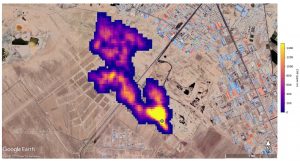China is seeking to develop weapons with the capacity to render western satellites useless and unable to transmit data or surveillance images during wartime, according to a leaked US document.
A CIA-marked document reviewed by the Financial Times – one of many allegedly shared by Jack Teixeria, US Air Guardsman arrested recently for a flurry of classified reports revealed online – said China was looking to create cyber weapons to “deny, exploit or hijack” enemy satellites.
Beijing reportedly views satellites as a key domain in modern or future conflicts, given the impact of the broadband internet service provided via satellites by SpaceX’s Starlink in pinpointing enemy positions in the war in Ukraine over the past 14 months.
The leaked report says the Chinese are preparing sophisticated cyberattacks that will enable them to mimic the signals that enemy satellites receive from their operators, and trick them into being taken over or malfunctioning.
ALSO SEE:
Russia Says China Agreed to Sell Weapons: US Leak – WaPo
This news follows remarks by General B Chance Saltzman, head of the US Space Force, set up just a few years ago, who told US lawmakers recently that Beijing had launched 347 satellites, including 35 over the past six months, as part of its goal of being the leading power in space by 2045.
Saltzman said satellites were aimed at monitoring, tracking, targeting, and attacking US forces in any future conflict.
“The threats that we face to our on-orbit capabilities from our strategic competitors [have] grown substantially,” he told CNBC.
“The congestion we’re seeing in space with tracked objects and the number of satellite payloads, and just the launches themselves, have grown at an exponential rate.”
Saltzman said satellite constellations could face an array of threats, from devices such as jammers, lasers, or “dazzlers” that could prevent them capturing images or relaying data back to earth.
“We’re seeing satellites that actually can grab another satellite, grapple with it and pull it out of its operational orbit. These are all capabilities they’re demonstrating on-orbit today, and so the mix of these weapons and the pace with which they’ve been developed are very concerning,” he was quoted as saying.
General Saltzman said last week the Space Force would be able to conduct “full spectrum operations” in orbit within a few years, hinting that a new space weapon that could be used offensively is being developed.
Saltzman’s remarks to the Senate defense appropriations committee lacked detail as the Space Force rarely discusses its offensive capabilities, but “suggests the ability to conduct both offensive and defensive operations”, Air & Space Forces magazine reported.
- Jim Pollard
ALSO SEE:
China’s Low-Earth Satellites Push in Starlink Catch-Up Bid
Musk’s Starlink Spurs Taiwan Satellite Internet Plan – Fortune
South Korea Joins Asian Space Race With Satellite Launch
CCP Asked Elon Musk Not to Sell Starlink in China – The Verge
China’s Military Fears Elon Musk’s Starlink – PLA Daily
US Lauds SpaceX Shutdown of Russian EM Attack – Defense News
























